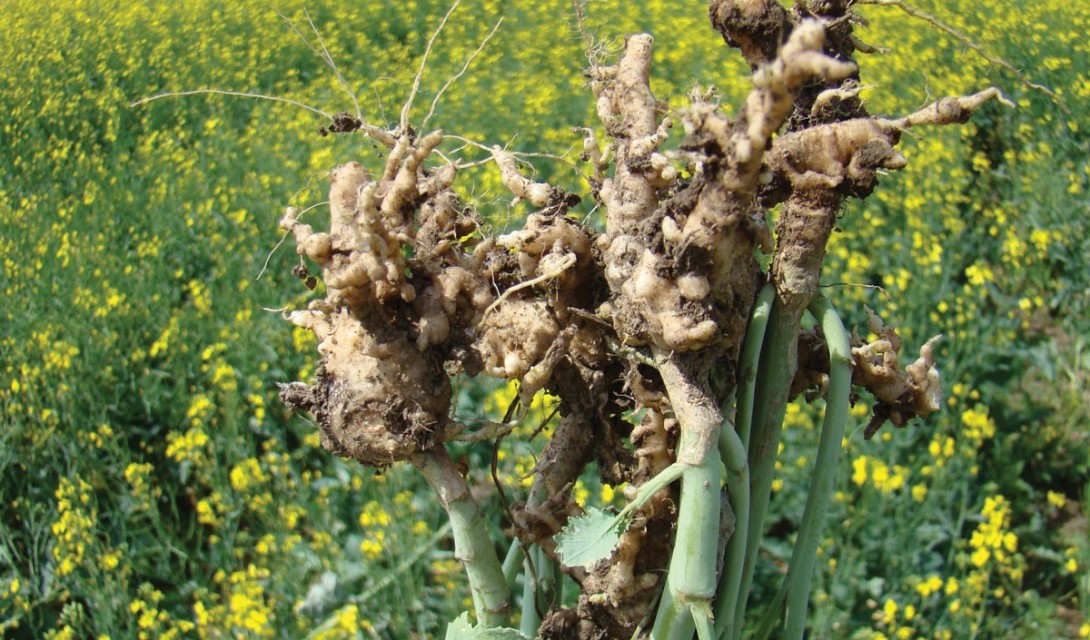© 2025, Nutrien Ag Solutions, Inc

Clubroot can be a sneaky disease – the pathogen, Plasmodiophora brassicae, causes galling of canola roots which restricts the ability of the plants to absorb water and nutrients. This can result in wilting or dying plants if the infection is severe enough.
These symptoms, however, can look very similar to canola suffering from other diseases such as blackleg, root rot or sclerotinia, insect damage such as cutworm or wireworm feeding, or environmental stresses such as drought, waterlogging or nutrient deficiencies.
From the road in particular it’s very difficult to identify clubroot infection, so it’s imperative growers get into their fields to check the crop.
According to Coreen Franke, manager, phytopathology research with Nutrien Ag Solutions, clubroot often shows up in canola fields in noticeable patches of wilting or prematurely ripening plants.
“In fields with no history of clubroot, the diseased patches are most often found at field entrances where clubroot-infested soil may have been first deposited by contaminated equipment,” she notes. “In fields with a history of this disease, highly infested patches are commonly found in areas with increased moisture, such as low spots or near sloughs.”
In order to identify clubroot, it is necessary to walk into the field and examine the crop more closely. Twyla Jones, manager of agronomic services with Nutrien Ag Solutions, says growers should look for patches of canola that are ripening prematurely if it has already podded.
“Any patch of canola that appears to be stressed in an area of the field where you wouldn’t expect it, such as hilltops and areas of compaction, should be investigated,” says Jones. “Pull the plant and look for the physical presence of galls on the root tissue. If it is a small patch, consider pulling all of the plants and burning them.”
Root galls are most easily identified late in the season, approximately two weeks before swathing, but if clubroot has become established and pathogen levels are high, infection can be severe and wilting or dying plants will be evident earlier in the season. If caught early, small patches can be isolated and managed to prevent further spread. Planting grass in these patches and pulling infected plants from these areas will help diminish spore loads and keep soil from moving.
While there are many circumstances beyond a farmer’s control, there are things he or she can do to make sure infested soil does not end up on his or her farm. The first tactic is prevention. “Avoid infested fields and reduce the risk of introducing clubroot spores onto the farm,” says Franke. “Be aware that clubroot spores can also be inadvertently transferred by things such as soil on seed potatoes or custom applicators’ equipment.”
In addition, minimize soil transfer by cleaning/sanitizing vehicles, equipment, tools and footwear; control volunteers and cruciferous weeds that can act as hosts for clubroot; implement a minimum of a two-year break between clubroot host crops; grow clubroot resistant (CR) hybrids; and finally, scout fields.
Early detection allows for early management. If clubroot is detected, keeping spore numbers low is key. A minimum two-year break between canola crops will significantly reduce the number of viable clubroot spores in the soil and is absolutely essential for managing the disease, says Franke.
“The best way to prevent the spread of clubroot is to know if you have it,” says Jones. “Growers are certainly taking clubroot seriously, and those growers in areas with newly introduced clubroot can learn from their Alberta counterparts on prevention and management.”
Clubroot continues to be a growing threat – its geographical range is rapidly expanding, new virulent pathotypes are appearing and resistance in many of the current CR hybrids is no longer effective in some areas. But growers can control the spread of clubroot effectively if they’re vigilant.
“The future of successful canola production will rely on growers’ awareness, and their concerted efforts to prevent and properly manage this disease,” says Franke.
> Explore the latest in Clubroot defense from Proven Seed
